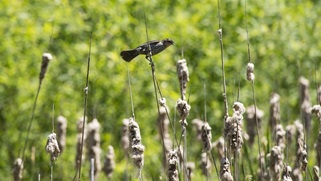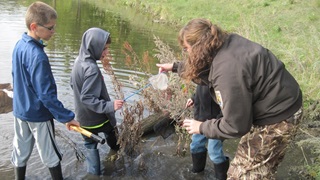Spreading wings for conservation, biodiversity
Minnesota Dragonfly Society performing critical research, conservation and educational work
Rachel MaKarrall is a dragonfly enthusiast. And she says they’re definitely worth the buzz.
“They’re the most beautiful of creatures—big, boldly colored, fantastic flyers with a voracious appetite,” she says. “And they eat mosquitoes among other insects, so people like that.”
But dragonflies are important for another reason too, MaKarrall explains.
“The presence of dragonflies can signal a healthy ecosystem and when we find them on a wetland, for example, we know the area is biologically functional.”
MaKarrall, who teaches entomology at the University of Minnesota Duluth, is on the board of the non-profit Minnesota Dragonfly Society—which recently received $50,000 in funding as part of Enbridge’s three-year, $3-million Ecofootprint Grant Program.
The funding will help the society continue its research, conservation and educational work on dragonflies and damselflies—a smaller, more delicate relative of the dragonfly— in Minnesota.
The society is currently focused on detailed survey work on dragonflies and damselflies on the St. Louis River and Red Lake watershed, in northern Minnesota, to benefit the entire state. Ecofootprint grant funds will be used to obtain critical data on the ranges of habitats of Minnesota’s dragonfly and damselfly species, especially those listed by the state as threatened or special concern species.
“Our survey work will be primarily focused on the nymph stage of these insects, since finding nymphs indicates the area is an important breeding ground,” says MaKarall.
With support from Enbridge, the society will also hold public workshops throughout the region—to educate the public on the importance of dragonflies to the health of our environment, and enlist residents’ help in data collection.
“These are family-friendly events, and the kids love to catch dragonflies with our nets,” says MaKarrall. “We teach the children how to catch them, how to record a specimen, and then how to release it back into the wild. Our organization just keeps growing as more people learn about how interesting these insects are.”
Launched in the spring of 2015, Enbridge’s Ecofootprint Grant Program will provide $3 million over the next three years to communities in Minnesota, North Dakota, and Wisconsin along the Sandpiper Pipeline and Line 3 Replacement project routes.
“The Ecofootprint Grant Program is designed to support a range of environmental projects that will provide a lasting impact in communities where we operate,” says Cindy Finch, a Minnesota-based senior public affairs advisor with Enbridge.
“We’re proud to help fund a non-profit like the Minnesota Dragonfly Society because it’s engaged in important work that’s helping to educate people and protect our environment at the grassroots level.”
Administered in partnership with the Minnesota Association of Resource Conservation and Development Councils, the program looks to advance locally based environmental priorities and grassroots stewardship projects.
“This is the largest grant our young society (established in 2013) has ever received, so we’re very happy that Enbridge is helping to further our efforts,” says MaKarrall. “We’ve mainly focused our research and educational activities in the Minneapolis-St. Paul metro area, and Enbridge’s grant will help us expand our work to the rural western and northern parts of the state.”










